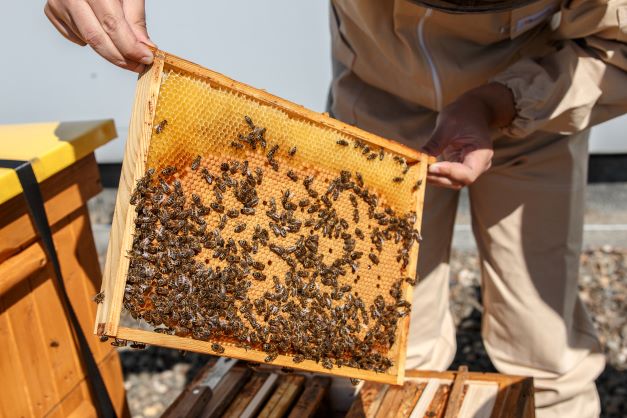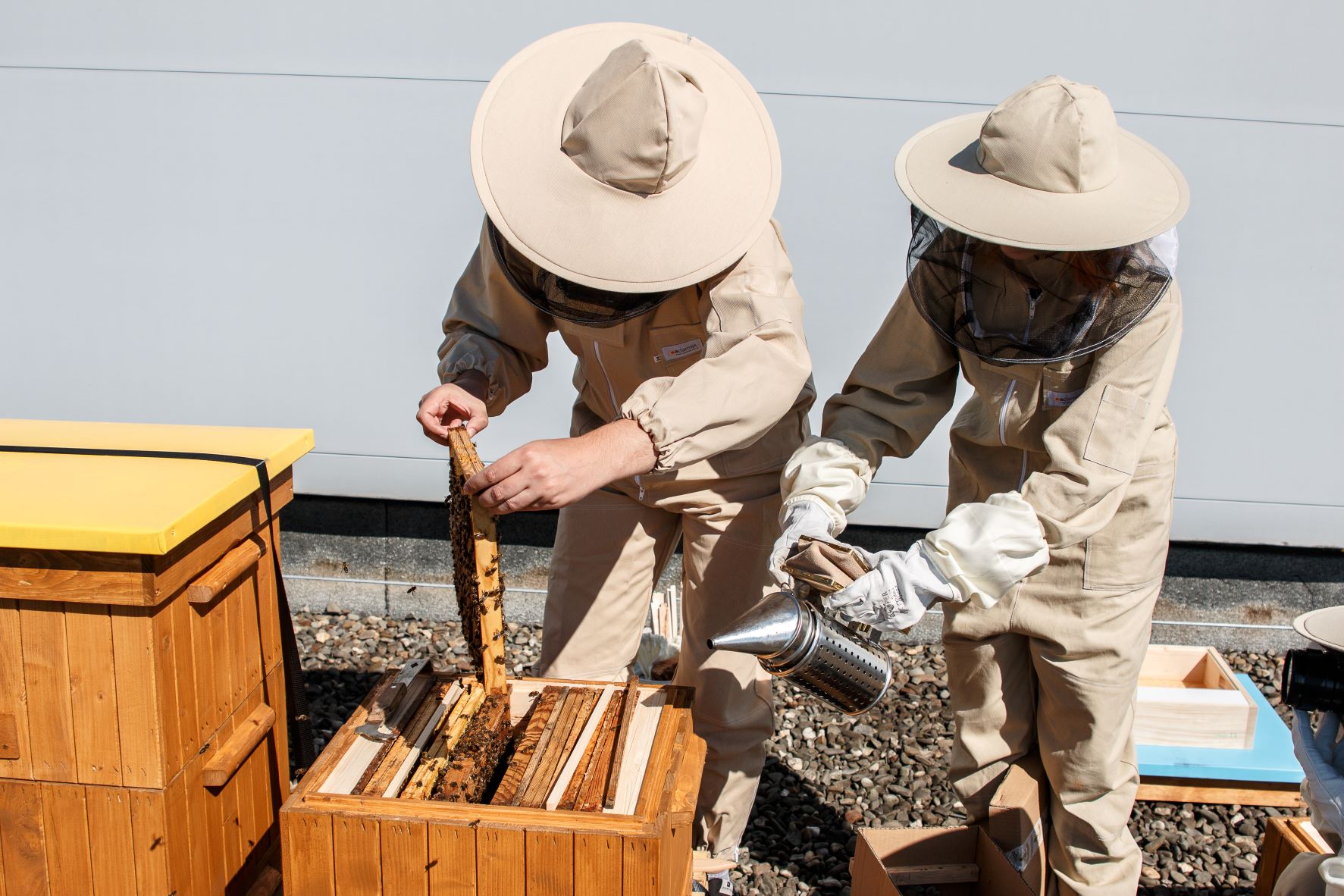RESEARCH EXCELLENCE INITIATIVE
FREEDOM OF RESEARCH – SCIENCE FOR THE FUTURE
“Freedom of Research – Science for the Future” series consists of articles, interviews and short videos presenting research conducted by the winners of the “Freedom of Research” call for proposals
Agata Nicewicz, PhD
To war with the bee tormentor
| Weronika Cygan |
For years, scientists and beekeepers have been sounding the alarm over the Colony Collapse Disorder (CCD). Bees are threatened by pesticides, climate change and parasites, contributing to a substantial decline in their numbers. Varroa destructor – a type of mite that causes deadly varroasis, is especially dangerous for the honey-producing insect.
Varroa is responsible for huge losses in the beekeeping industry and in the natural environment. As part of the competition “Freedom of Research” of the Research Excellence Initiative Agata Nicewicz, PhD from the Faculty of Natural Sciences of the University of Silesia conducted research aimed at estimating the effectiveness of the methods used in Poland to combat V. destructor.
“Varroa is the vector of at least sixteen viruses that cause various diseases. They can cause, among others, paralysis of bees, which often results in their death”, explains Agata Nicewicz, PhD. Sometimes it happens that the disease does not kill the bee, but changes its body: the bee loses body hair and its cuticle turns black. Such bee smells different from its healthy sisters, which is why it is sometimes treated as an intruder and is not allowed into the hive. The lone bee, exposed to attacks by its past companions, dies from hunger and cold outside its former home, if it is not killed before that.
A cunning pest
For a long time it was believed that V. destructor acted like a tick, digging into the skin of the victim and drinking the hemolymph (the equivalent of blood in insects). It was not until the 2019 publication that this view was refuted. “It turned out that the main source of food for Varroa is the fat body of the bees. It is the tissue in which proteins related to the immune system are synthesized. At the same time, it acts as an energy storage. Here, too, the neutralization of toxins takes place”, explains the researcher from the University of Silesia. The parasite not only destroys the fat body, but also injects viruses with its saliva. The attacked bee suffers from a lack of immunity and attenuation of the system.
Varroa is an extremely cunning pest. It can wait a few days in a flower, waiting for the bee it will latch onto and return to the hive with it. According to research, V. destructor recognizes the smells of specific individuals, therefore it does not attack the bees from the colony it came from, but looks for its prey elsewhere. It is, among others, this ability of Varroa which makes it such a difficult opponent for beekeepers as well as a threat to other species of animals.
“Bees can travel long distances and fly up to 10 km from the hives. They have contact with the entire environment and with other insects. Unfortunately, honeybees also infect other pollinators. In Great Britain, one of the wild bumblebees species became extinct because it was unable to fight V. destructor”, explains Agata Nicewicz, PhD.

Agata Nicewicz, PhD | Agata Nicewicz, PhD’s private archive
The turn of summer and autumn is a period of increased vigilance for beekeepers. This is when the first signs of the parasite’s presence and symptoms of varroasis can appear. Varroa inhabits adults, but it can also take interest in the larvae it sneaks into before the bees seal the cell. Hidden this way, the pest has an abundance of warmth and food. It happens that in one such cell there are three or four Varroa.
According to the scientific literature, an untreated bee colony affected by varroasis will go completely extinct within two years. Agata Nicewicz, PhD claims, however, that such a loss can happen in the same year the parasite has taken over the family. This is also confirmed by the experiences of beekeepers with whom the researcher spoke – some of them complained about losses of up to half of all bees, despite the use of autumn treatment. It is therefore not surprising that scientists and apiculturists are involved in finding the most effective method of pest control.
Searching for a solution in genetic engineering
For years, efforts have been made to breed lines of honeybees that are more resistant to Varroa attacks. It is known that some individuals show the so-called hygienic behaviour consisting of combing one’s own body and removing impurities. Scientists hope that the reaction will be strengthened in such a way that the bee itself is able to pull the parasite from the body, and even open the cells with larvae infected by it and extract them.
Some researchers are trying to use genetic engineering to modify Varroa itself, wanting to make their males or females sterile. Unfortunately, the above-mentioned actions do not have the desired effect so far. As Agata Nicewicz, PhD explains: “The research is still ongoing, but the problem lies in the scale. The hygienic behaviour of the honey bee is influenced by many genes. It is not fully known whether all of them have been discovered, so it is difficult to put all our hopes in genetic engineering at this point”.
Therefore, beekeepers mainly have to use chemicals to weaken the parasite. The most commonly used organic chemical is amitraz. As part of the “Freedom of Research” competition, Agata Nicewicz, PhD studied the sensitivity of V. destructor to this pesticide. Scientific research was carried out in one reference apiary in the Łódź Voivodeship and in four experimental apiaries in the Śląskie and Mazowieckie Voivodeships.

Bees from the University’s apiary | Photo by Julia Agnieszka Szymala

Employees of the University of Silesia by the apiaries | Photo by Julia Agnieszka Szymala
Tried weapon against the parasite
Amitraz remains the most effective agent to combat the pest at the moment, but its effectiveness is clearly declining due to the resistance acquired by the species. The cause may be excessive and uncontrolled use of the substance. “Varroa is already resistant to many formerly used pesticides”, notes the researcher from the University of Silesia and cites the report of one of the beekeepers who used amitraz treatment in his hives.
“The beekeeper collected the dead specimens in a jar in order to count them and see if the treatment he had undertaken made sense. After two days, he noticed that all the specimens were alive and were marching along the walls of the closed jar. It turned out that they were only temporarily paralysed. If he simply left them near the hive, they would certainly come back to it”, says Agata Nicewicz, PhD.
Still, it should be remembered that amitraz affects not only the parasite, but also the bee. With uncontrolled and excessive use of the pesticide, it can have a negative effect on the honey producer and its invertebrate trachea. It is therefore important that beekeepers themselves become more aware of the effects of the substances they use.
Agata Nicewicz, PhD emphasises that it is not about a complete departure from amitraz, but about its proper use. Combined treatment, i.e. with the use of additional measures, may also be a solution. According to the research of the biologist, this approach brings good results, as evidenced by the University’s apiary located on the roof of the Faculty of Law and Administration of the University of Silesia. After the imprementation of the combined treatment, the rates of V. destructor’s resistance to amitraz were lower than in the control apiaries, where the bees were treated with organic acids.
Although it is not easy for pollinators, as they are being decimated by the parasite, in addition to the threat posed by the climate change and environmental pollution, scientists and beekeepers are constantly looking for new, better methods to protect bees from mass extinction. It is hoped that Varroa will be kept in check.





